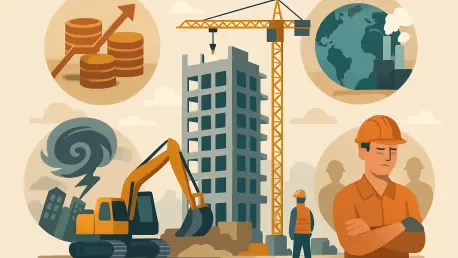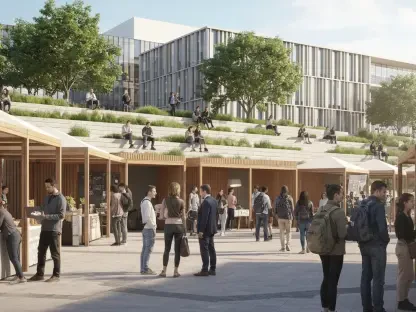In a year marked by uncertainty, the global construction industry finds itself at a pivotal moment, as detailed in the latest Engineering News-Record (ENR) Top 250 International Contractors report, which highlights a sector grappling with marginal revenue growth of just 0.5%, reaching a collective total of $501.2 billion. Yet, beneath this modest uptick lies a more troubling reality: a 2.7% decline in median international revenue, slipping from $477.07 million in 2023 to $464.36 million in 2024. Such figures reflect an industry caught in the crosswinds of economic instability, geopolitical tensions, and operational challenges that threaten to derail even the most established firms. From fluctuating material costs to persistent labor shortages, contractors are navigating a landscape where progress feels increasingly elusive.
The report paints a sobering picture of a “new normal” defined by volatility. Supply chain disruptions, exacerbated by global conflicts and trade policy shifts, have compounded the difficulties of managing complex projects across diverse regions. Meanwhile, stark disparities in regional performance and sector-specific trends reveal an uneven playing field, where opportunities in some areas are offset by significant declines in others. As the industry adapts to these multifaceted hurdles, the focus shifts to resilience, strategic innovation, and a renewed emphasis on core strengths. This exploration delves into the critical forces shaping the current environment and the adaptive measures contractors are employing to stay competitive.
Economic Pressures and Stagnant Growth
The financial outlook for the Top 250 international contractors reveals a sector under strain, with economic uncertainty casting a long shadow over modest gains. Achieving a collective revenue of $501.2 billion marks a slight 0.5% increase, but this figure belies deeper issues as median revenue dropped sharply by 2.7%. This disparity suggests that while some firms are holding steady, many are struggling to maintain profitability in an environment marked by unpredictable cost escalations. Global economic downturns, lingering since the disruptions of earlier years, have tightened budgets and squeezed margins, leaving contractors vulnerable to even minor market shifts. The persistent impact of past recessions, combined with ongoing regional instabilities, creates a challenging backdrop that tests the financial endurance of even the most robust players.
Beyond the numbers, industry leaders express growing concern over the unpredictability of expenses that complicates long-term planning. Material costs, labor rates, and equipment pricing fluctuate with little warning, turning project budgets into moving targets. This financial instability forces firms to adopt more conservative strategies, often prioritizing risk management over aggressive expansion. The broader economic climate, shaped by lingering global challenges, continues to hinder the ability to forecast with confidence, pushing contractors to rethink traditional approaches to growth. As a result, the focus has shifted toward stabilizing operations and safeguarding profit margins in a landscape where every decision carries heightened stakes.
Supply Chain Woes Amplify Costs
Supply chain disruptions remain a critical obstacle for international contractors, driving up project costs and delaying timelines across the board. Global conflicts, such as the ongoing Russia-Ukraine war and unrest in the Middle East, have destabilized key markets, spiking petroleum prices and snarling logistics networks. These external pressures create a domino effect, where delays in material deliveries lead to cascading setbacks on construction schedules. The resulting cost volatility has become a pervasive issue, forcing firms to absorb unexpected expenses or pass them on to clients, often at the risk of strained relationships. This persistent challenge underscores the fragility of global supply networks in an era of heightened geopolitical tension.
In response to these disruptions, many contractors are seeking ways to insulate their operations from external shocks. Diversifying supplier bases has emerged as a key tactic, with firms spreading their procurement across multiple regions to reduce dependency on any single source. Additionally, enhancing in-house capabilities offers a buffer against delays, allowing companies to maintain tighter control over critical components of their projects. Industry voices, such as Dorçe’s General Manager Doruk Coşkunsu, highlight the added burden of customs duties and import restrictions in regions like Africa and Asia, which further complicate supply logistics. These adaptive measures reflect a broader shift toward self-reliance and flexibility as contractors strive to mitigate the impact of an unpredictable global market.
Labor Shortages Strain Project Delivery
The scarcity of skilled labor continues to pose a significant barrier for contractors, with rising costs and project delays becoming commonplace. As projects grow in complexity, the demand for specialized talent has outstripped supply, particularly in emerging markets where infrastructure needs are expanding rapidly. In regions like Africa, the challenge is especially acute, with escalating expenses tied to the limited availability of qualified workers. This shortage not only drives up wages but also forces firms to extend timelines, as they scramble to fill critical roles. The ripple effects of this issue are felt across all levels of operation, from planning to execution, creating a bottleneck that hinders progress.
To address this persistent challenge, contractors are exploring innovative solutions to bridge the talent gap. Tapping into local labor markets has become a priority for many, as it reduces costs and fosters goodwill within host communities. Collaborative partnerships with educational institutions and training programs are also gaining traction, offering a long-term approach to building a skilled workforce. Some firms advocate for cross-border labor agreements to access talent from neighboring regions, while others invest in technology to automate tasks traditionally performed by human workers. These strategies reflect a multifaceted response to a problem that shows no signs of abating, as contractors seek sustainable ways to maintain project momentum in a competitive environment.
Geopolitical and Trade Policy Challenges
Geopolitical instability and evolving trade policies are adding layers of complexity to an already challenging landscape for international contractors. The reintroduction of U.S. tariffs under President Donald Trump’s administration, announced on April 2, has sent shockwaves through the industry, inflating the cost of essential materials and equipment. These unexpected expenses disrupt budgets and force firms to reassess procurement strategies on short notice. Beyond tariffs, broader geopolitical tensions, including conflicts in key regions, exacerbate supply chain issues and heighten market uncertainty. The unpredictability of such policies creates an environment where long-term planning becomes a gamble, testing the adaptability of even the most seasoned contractors.
In navigating these turbulent waters, many firms are adopting defensive measures to shield themselves from policy-driven risks. Incorporating escalation clauses into contracts has become a common practice, allowing for adjustments in pricing should tariffs or regulations shift unexpectedly. A cautious approach to new commitments is also evident, with companies like Skanska prioritizing flexibility over aggressive expansion in volatile markets. Industry leaders note the importance of staying informed on global developments, as sudden changes in trade rules can alter project economics overnight. This focus on risk mitigation highlights a broader trend of strategic conservatism, as contractors balance the need for growth with the imperative to protect their bottom lines.
Regional Performance Variations
The revenue performance of the Top 250 contractors in 2024 reveals striking disparities across global regions, reflecting the uneven impact of economic and local conditions. The Caribbean emerged as a standout, posting a remarkable 37.7% revenue increase, while the Middle East followed with a robust 17.7% gain and Australia recorded a solid 13.9% uptick. These bright spots contrast sharply with Latin America, which experienced a 9.9% decline, marking a reversal from previous years of growth. Such variations underscore how regional dynamics, from political stability to infrastructure demand, shape the fortunes of contractors operating in diverse markets. The data points to a fragmented industry landscape where success hinges on understanding and adapting to local realities.
These regional differences compel contractors to adopt tailored strategies rather than one-size-fits-all approaches. In high-growth areas like the Caribbean and Middle East, firms are capitalizing on booming demand for infrastructure and energy projects, often aligning with government priorities to secure contracts. Conversely, in struggling markets like Latin America, the focus shifts to cost control and selective project engagement to minimize losses. The ability to pivot based on regional trends becomes a competitive edge, as contractors must navigate not only economic cycles but also cultural and regulatory nuances. This adaptability is critical in a global market where opportunities and challenges are distributed unevenly, demanding a keen awareness of local conditions to drive sustainable growth.
Sector Dynamics and Strategic Focus
Sector-specific trends in 2024 highlight a mixed outlook for international contractors, with significant declines in some areas offset by growth in others. Manufacturing and industrial process sectors contracted by 3.3% and 10.6%, respectively, while oil and gas took a substantial hit with a 13.6% revenue drop. In contrast, sectors like sewer and waste saw an impressive 18.4% increase, telecommunications grew by 14.2%, and water supply rose by 12.2%. These shifts reflect broader economic priorities and environmental imperatives, as governments and private entities invest in critical infrastructure and sustainable solutions. For contractors, understanding these trends is essential to aligning resources with market demand.
In response to this varied landscape, many firms are doubling down on sectors where they hold competitive advantages. Companies focusing on high-growth areas such as water treatment and telecommunications are positioning themselves to capture emerging opportunities, often through specialized expertise and strategic partnerships. Meanwhile, those in declining sectors like oil and gas are reevaluating their portfolios, seeking to diversify or pivot to adjacent markets with stronger prospects. This emphasis on core competencies over broad expansion reflects a pragmatic approach to navigating uncertainty, ensuring that resources are allocated where they can yield the greatest return. Such targeted strategies are becoming a hallmark of resilience in an industry where adaptability is paramount.
Pathways to Resilience and Innovation
As the international construction sector grapples with volatility, contractors demonstrate a commitment to forging new paths through innovation and strategic realignment. Many have turned to technology, adopting advanced project management tools to enhance efficiency and transparency in operations. Collaborative contracting models have also gained traction, fostering trust and shared accountability among stakeholders to better manage risks. These approaches mark a departure from traditional methods, reflecting an industry-wide recognition that past practices are often ill-suited to current challenges. The push for digitalization and partnership underscores a broader effort to build a more agile and responsive framework for tackling complex projects.
Localization has emerged as another cornerstone of adaptation, with firms prioritizing regional labor and supplier networks to mitigate supply chain risks and comply with local regulations. This focus not only reduces costs but also strengthens ties with host communities, aligning projects with national development goals. Sustainability, too, has become a competitive driver, as contractors integrate green practices into their workflows to meet evolving client expectations. Looking back, these efforts have laid a foundation for navigating an uncertain future, offering actionable steps like investing in workforce training and technology to bolster resilience. As the industry reflects on these initiatives, the emphasis remains on evolving strategies to address both immediate hurdles and long-term aspirations.









